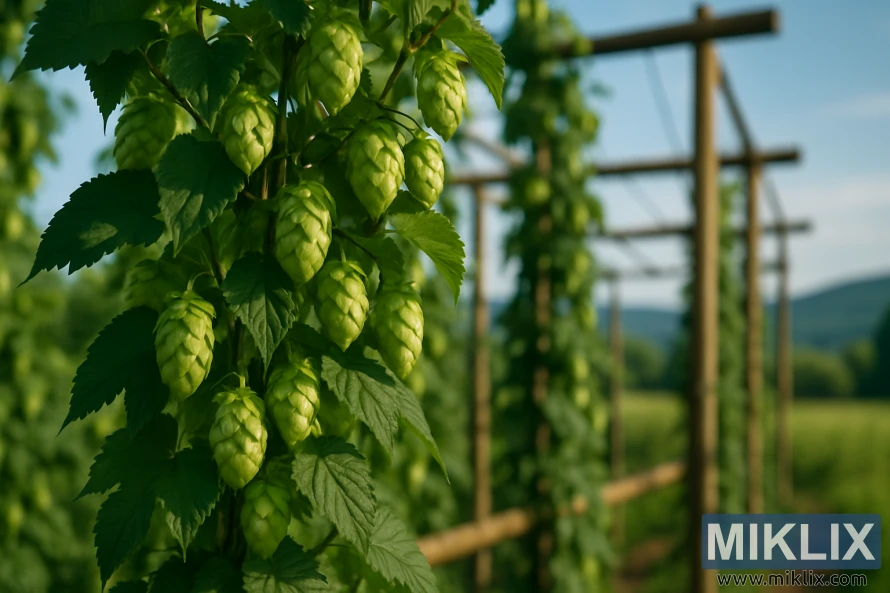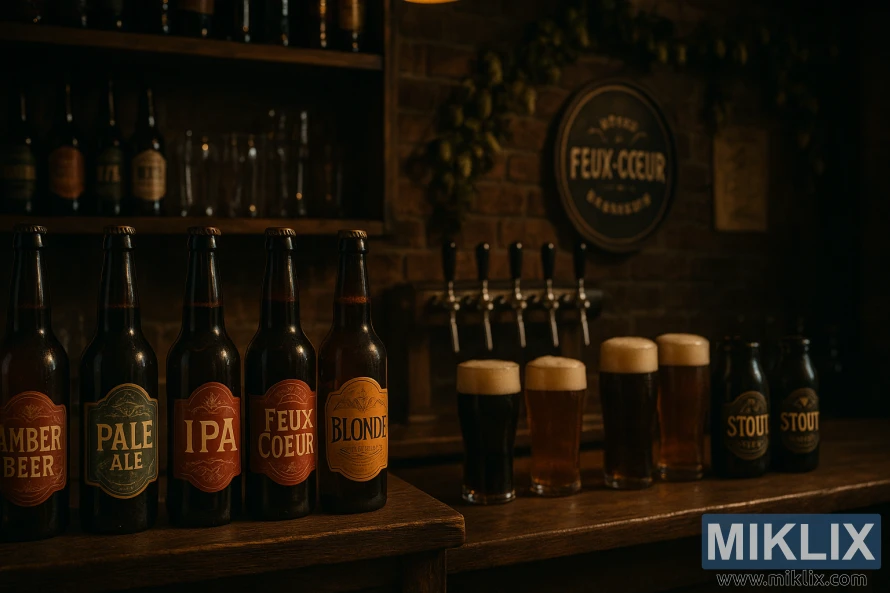Hops in Beer Brewing: Feux-Coeur
Published: November 24, 2025 at 12:17:46 AM UTC
The Feux-Coeur hop variety is a standout among Australian varieties and is noted for its bittering and aromatic qualities.

Key Takeaways
- Feux-Coeur hops are a notable member of Australian hop varieties with both bittering and aromatic uses.
- The article compiles technical and practical insights drawn from Beermaverick and Beer-Analytics.
- Content is aimed at brewers seeking clear guidance on chemistry, cultivation, and recipes.
- Later sections will cover substitutions, supplier notes, and harvesting techniques.
- This piece serves as a single reference for Feux-Coeur Francais in hops in beer brewing.
Introduction to Feux-Coeur and Its Role in Brewing
Feux-Coeur Francais, an Australian-bred hop, is renowned for its bittering capabilities. In an introduction to Feux-Coeur, brewers discover its ability to deliver clean, steady bitterness. This is achieved without leaving a strong aromatic footprint.
For those inquiring about the Feux-Coeur hop, it's a specialty bittering variety. It's mainly used during the boil to extract alpha acids. This contrasts with late additions, whirlpool work, or dry hopping, where aroma oils are more critical.
Feux-Coeur's role in brewing is functional and specific. It's ideal when a recipe demands controlled bitterness but doesn't require a dominant hop aroma. This hop balances the beer, allowing aromatic varieties like Citra, Hallertauer, or Saaz to take center stage.
Within the broader context of bittering hops, Feux-Coeur is an uncommon, niche choice. Its limited availability and modest profile add to its allure among craft brewers and hop buyers. They seek alternatives to mainstream bittering options like Magnum or Warrior.
- Use case: early boil additions for predictable IBUs.
- Strength: provides bitterness without masking malt or yeast character.
- Audience: experimental brewers seeking subtlety and rarity.
Origin and Genealogy of Feux-Coeur
Feux-Coeur Francais was first harvested in 2010, after years of selection and field trials. Its origin links modern Australian cultivation to the older Burgundian French genetics. Growers in Victoria and Tasmania reported promising yields during early commercial trials.
The hop's pedigree reflects deliberate crossing within an Australian hop-breeding program. Breeders combined international germplasm with local strains to produce the desired aroma and agronomic traits. Records of Feux-Coeur genealogy note contributions from French hop material alongside Australian parent lines.
Though the name highlights a French link, the variety's commercial emergence is clearly Australian. Planting, evaluation, and initial scale-up happened under Australian hop breeding efforts. This geographic development helped adapt the genetics to southern hemisphere seasons and soil types.
The industry context shows a trend toward hybrids that merge regional genetics with global flavor profiles. Feux-Coeur genealogy exemplifies this approach by blending Burgundian French genetics with Australian selection to meet brewer and grower needs. Small-batch trials by craft breweries helped refine its market role.
- First harvest: 2010, Australia
- Breeding: Australian hop breeding program
- Lineage: Includes Burgundian French genetics
- Commercial ties: Developed and cultivated in Australia
Physical Characteristics and Growing Regions
Feux-Coeur plants exhibit a compact cone with a firm bract structure. Notes often mention lupulin content but lack specific totals. Growers and brewers must rely on sensory testing and batch reports due to missing oil figures.
Hop physical characteristics highlight a medium-sized cone, slightly elongated tip, and sticky lupulin pocket. Visual inspection is key for judging freshness when analytical data is absent. It's advisable to pick samples from harvests over relying solely on spec sheets.
Feux-Coeur's growing regions are predominantly in Australian hop farms. Commercial plantings are mainly in Victoria and Tasmania, where the climate is suitable. Small, experimental plots are found in New South Wales and Western Australia.
Reports indicate a rare, limited presence in the United States. Availability in American markets is scarce, often tied to single harvest imports. Brewers in the U.S. should plan orders early for specific crop years.
Crop variability impacts appearance and performance from year to year. Chemical ranges and hop physical characteristics can change by harvest and supplier. Suppliers may list Feux-Coeur Francais with different harvest years and amounts, leading to varied results in the brewhouse.
- Grower location: mainly Australian hop farms with limited overseas trials.
- Physical profile: medium cones, visible lupulin, many values flagged as unknown.
- Supply notes: inconsistent commercial quantities across harvest years.
Field notes from brewers suggest inspecting sample lots for aroma and lupulin color before purchase. These practical checks help offset gaps in published data about Feux-Coeur plant traits and oils.

Chemical Brewing Values and Alpha Acids
Feux-Coeur alpha acids exhibit a wide range in published data. Beermaverick notes a 12%–16% range, with an average of 14% for Feux-Coeur Francais. In contrast, Beer-Analytics reports a much lower range, around 4%–6.4%.
This discrepancy highlights the need for brewers to view hop alpha acid percent as tentative. They should rely on historical ranges and supplier trends when crafting recipes. Always confirm the hop alpha acid percent on the batch tag before calculating additions.
Alpha acids are key to boil-derived bitterness. Longer boil times lead to more isomerization, increasing bitterness. Adjust kettle timing to achieve the desired IBU, considering the variability in Feux-Coeur alpha acids.
The source of hops is critical for accurate brewing values. Different suppliers and labs employ distinct analysis methods, and harvest conditions can vary yearly. Always request the supplier's technical sheet or lab certificate for the specific harvest you purchase.
- Check the batch tag for hop alpha acid percent before brewing.
- Use a conservative average when published figures conflict.
- Adjust boil time if the bitterness Feux-Coeur contributes seems off.
When planning recipes, consider the range of reported values, not just a single figure. This approach ensures consistent bitterness and minimizes the need for adjustments during fermentation or blending.
Beta Acids, Alpha-Beta Ratio, and Bitterness Profile
Feux-Coeur beta acids range from 3.1% to 6%, averaging around 4.6%, according to Beermaverick. Brewers closely monitor these numbers. They impact the bitterness that develops as beer ages.
The alpha-beta ratio is critical in determining how hop bitterness evolves over time. Beermaverick indicates Feux-Coeur's ratio varies from 2:1 to 5:1, with an average of 4:1. A higher ratio means more immediate iso-alpha bitterness from boil additions. A lower ratio suggests a greater contribution from beta-derived bitterness as the beer matures.
Details on hop cohumulone in Feux-Coeur are not available in public technical sheets. Low cohumulone levels typically result in smoother bitterness. Without clear cohumulone figures, predicting the taste of Feux-Coeur remains uncertain.
Feux-Coeur can serve as a medium-to-high alpha bittering hop in various recipes, based on reported alpha values. The combination of alpha and beta acids suggests a bitterness profile that evolves with cellaring. Beta acids play a significant role in the changing bitterness nuances.
- Beta acid range: 3.1%–6% (average ~4.6%) — affects aged bitterness.
- Alpha-beta ratio: reported 2:1–5:1 (average ~4:1) — influences immediate vs. aged bitterness.
- Cohumulone: unknown — limits precise sensory predictions.
Brewers should view these values as guidelines. For more precise information, hop analytics from suppliers or lab testing can provide clarity. This is essential for refining expectations of the bitterness profile Feux-Coeur will have in the finished beer.
Oil Composition and Aroma Considerations
Feux-Coeur hop oils are not well-documented in public databases. Beermaverick lists total oils for Feux-Coeur Francais as unknown. Beer-Analytics and industry notes echo that individual breakdowns are not broadly reported.
Common hop essential oils like myrcene, humulene, caryophyllene, and farnesene are typical targets when analyzing varieties. For Feux-Coeur, detailed percentages for those compounds have not been published. This gap leaves limited hop oil data for brewers seeking clear aromatic guidance.
Professional sources classify Feux-Coeur mainly as a bittering hop. Descriptive aroma notes are sparse and sometimes treated as confidential by breeders and suppliers. As a result, Feux-Coeur aroma expectations should be conservative when planning late additions or dry hopping.
Practical brewing advice recommends small-scale sensory trials if you want aromatic input from this variety. Confirming the hop’s character through pilot batches or tasting panels reduces risk. Consult supplier technical sheets and tasting notes when available for additional context.
- Do not assume Feux-Coeur hop oils mirror well-known aroma varieties.
- Use early additions for bittering roles and test late additions before full-scale use.
- Record sensory data from trials to build private hop oil data for future brews.

Feux-Coeur hops
Feux-Coeur Francais summary: a hop bred in Australia, focusing on bitterness. It comes from Burgundian French stock. Growers see it as ideal for base bitterness, not for late-hop aroma.
Feux-Coeur is found in supplier catalogs and hop comparison sites. Its availability changes with harvest year, lot size, and price. It's sold through craft suppliers and online platforms like Amazon when in stock.
There are gaps in data for this hop. Details like co-humulone, total oils, and lupulin powder availability are often missing. No cryo or Lupomax versions from major processors like Yakima Chief, John I. Haas, or Hopsteiner have been documented.
- Typical use: primary bittering hop in recipes.
- Recipe share: Beer-Analytics notes it often makes up roughly a quarter of hop bills where used.
- Market note: listings vary by supplier and season.
When considering Feux-Coeur hops, expect varied catalog details. Sellers might list alpha ranges and crop notes but omit secondary metrics. Brewers should confirm the lot analysis before scaling a recipe.
For recipe planning, view Feux-Coeur as a strong Austalian bittering hop. Its role is clear: provide clean bitterness. This allows other aroma hops to shape the beer's final profile.
Flavor and Aroma Profile in Finished Beer
The Feux-Coeur flavor profile is characterized as restrained. Commercially, it's often used for bittering. This means the beer will have a firm bitterness from the boil.
Some brewers report faint fruity or floral hints when Feux-Coeur is added late. Others detect subtle woody or spice-like notes on careful tasting. These impressions can change based on the malt, yeast, and hopping schedule.
For brewers, the Feux-Coeur aroma in beer should be viewed as minimal. This is unless a large amount is added late or as a dry-hop. Small-scale trial brews are essential to confirm any delicate aromas before scaling up.
When used mainly for bittering, the beer will have clean, rounded bitterness. Any aromatic lift is low intensity and can be hard to discern without direct comparison with other hops.
- Expect bittering strength over floral punch.
- Validate subtle notes with small pilot batches.
- Match with neutral yeasts to reveal hop nuances.
Best Beer Styles and Recipe Uses
Feux-Coeur is a perfect fit for ales, with pale ales and IPAs being its ideal companions. It's chosen for its clean, subtle bitter backbone. In IPAs, it complements hops like Citra or Cascade, allowing them to take center stage.
As a bittering hop, Feux-Coeur excels in the boil. It's often added early in the boil schedule to establish IBUs. This allows later additions of aroma hops to enhance the beer's flavor. For those experimenting with lagers or pilsners, Feux-Coeur can introduce a unique bitterness in small batches.
Feux-Coeur is frequently paired with other hop varieties in recipes. It typically makes up a quarter of the total hop additions. Pairing it with complementary aroma hops balances its mild herbal and floral notes.
When crafting bittering hop recipes, always check the alpha values with your supplier. Adjust the IBUs as needed, avoiding historical averages. Start with 1–3 gallon test brews to fine-tune how Feux-Coeur performs in your brewing setup and catch any subtle flavor nuances early.
- Recommended styles: American IPA, pale ale, session ales.
- Experimental uses: lagers and pilsners in controlled trials.
- Formulation tip: treat it as a supporting bittering hop, not the sole flavor driver.

Pairing Feux-Coeur with Other Hops and Yeasts
Feux-Coeur hops are best used as a bittering base, complemented by aroma hops. Galaxy, Ella, and Cascade are often paired with Feux-Coeur. These hops add fruity, citrus, and floral notes that Feux-Coeur lacks.
For hop blending, use Feux-Coeur in early additions for bitterness. Add Citra, Galaxy, or Cascade in late whirlpool and dry hop additions. This method allows Feux-Coeur to manage bitterness while other hops enhance aroma and flavor.
Pairing Feux-Coeur with Galaxy brings out stone fruit and tropical flavors. Use small amounts of Galaxy in whirlpool additions and larger amounts in dry hopping. This approach maintains a clean bitterness and highlights Galaxy's tropical aromas.
Choosing the right yeast is key when pairing with Feux-Coeur. American ale yeasts like Wyeast 1056 or White Labs WLP001 enhance hop aromas. English ale yeasts add a warmer, malt-forward character if desired.
For hop-forward IPAs or pale ales, select neutral-fermenting yeasts. This prevents the yeast from overpowering the hop blend. For more complex ales, choose English or Belgian yeasts with minimal esters to keep the focus on hop blending.
- Use Feux-Coeur for bittering at boil.
- Layer Galaxy or Citra late for aroma.
- Dry hop with Ella or Cascade for citrus and floral lift.
- Pick a clean American ale yeast for clarity in hop character.
Adjust hop quantities and timing based on your recipe goals. For IPAs, increase late additions and dry hop levels. For balanced pale ales, reduce dry hopping and let Feux-Coeur's bitterness establish the beer's structure. These decisions refine the impact of Feux-Coeur hop pairings and yeast pairings on the final beer.
Substitutions When Feux-Coeur Is Unavailable
When Feux-Coeur hops are out of stock, brewers can turn to data-driven tools or their own experience. Beermaverick’s tool provides algorithmic guidance. Beer-Analytics and brewing write-ups also list suitable alternatives to Feux-Coeur for various recipes.
When selecting a substitute, consider the hop's role in your recipe. For bittering, match alpha acids to achieve the desired IBUs. For aroma or hybrid additions, focus on complementary oil profiles and aroma characters, not just alpha acid levels.
- Centennial — citrus and floral notes, alpha 7%–12%. Suitable for bittering or bright aroma when Feux-Coeur is unavailable.
- Northern Brewer — woodsy, minty tones, alpha 5%–9%. Ideal for mid-to-late additions, providing a resinous profile.
- Citra — strong citrus and tropical fruit, alpha 10%–15%. Great for aroma-forward beers and vibrant alternatives to Feux-Coeur.
Adjust quantities by calculating IBUs and considering utilization differences during boil. For aroma or hybrid roles, adjust late additions to maintain balance. Small test batches help reveal how a chosen hop replacement performs in your specific brewing conditions.
Practical use of alternatives to Feux-Coeur involves tasting and iteration. Track hop weights, steep times, and perceived bitterness. Note how resin, citrus, or floral oils evolve during fermentation and conditioning. This way, future substitutions become faster and more accurate.
Availability, Purchasing, and Supplier Notes
Feux-Coeur availability changes with the seasons and vendors. Small farms in France and larger distributors list batches irregularly. This means there can be gaps between when you can buy it and when it's available in stock.
Looking to buy Feux-Coeur hops? Check out specialty hop merchants, homebrew shops, and online marketplaces like Amazon. Retail listings are limited, so compare prices and lot sizes before making a purchase.
Feux-Coeur suppliers vary in their data reporting. Some provide detailed lab sheets with alpha and beta acids, cohumulone, and oil totals. Others only give basic ranges. Always ask for the hop analysis tied to the specific hop harvest year Feux-Coeur to ensure the chemistry and aroma meet your expectations.
Currently, no major vendors offer lupulin or cryo formats for Feux-Coeur. Yakima Chief Hops, BarthHaas, and Charles Faram do not list Cryo, LupuLN2, or Lupomax versions in their catalogs. So, whole-cone and pellet forms are your main options.
Here's a simple checklist to help you buy with confidence:
- Request the analysis sheet for the specific hop harvest year Feux-Coeur.
- Verify batch alpha acids and beta acids against your recipe needs.
- Confirm lot quantity and shipment date to avoid stale hops.
- Compare quotes from at least two Feux-Coeur suppliers for fair pricing.
Inventory can change quickly after harvest. If you need a rare lot, secure it early or sign up for supplier alerts. Keep an eye on the hop harvest year Feux-Coeur on listings to match sensory notes with the correct vintage.
For commercial brewers, demand certificates and chain-of-custody details when buying large lots. Homebrewers should opt for smaller, verified lots and store hops cold and dark to preserve aroma.

Cultivation Notes and Harvesting Techniques
Feux-Coeur is mainly recorded in Australian hop cultivation, where breeders selected types that suit warm, temperate coastal zones. Growers in the United States may encounter this variety only rarely, so regional experience is limited.
For timing a Feux-Coeur harvest, rely on cone condition, not calendar dates. Pick when cones are papery, spring back slightly when squeezed, and show rich, yellow lupulin. These signs mark peak flavor and bitterness.
Standard hop harvesting techniques apply. Hand-pick or machine harvest when cones are plump and bitterness compounds are mature. Avoid early picking that yields weak oils and low alpha acids. Wait too long and cones overripe, losing aroma and developing grassy off-notes.
Practical choices in cultivating Feux-Coeur include trellis height, irrigation scheduling, and pest scouting. Because public agronomy data on disease resistance, yield per acre, and vigor are sparse, consult breeders and suppliers for trial guidance before large-scale plantings.
- Monitor lupulin color and cone feel to judge Feux-Coeur harvest windows.
- Use gentle handling during picking to preserve delicate oils and resins.
- Record seasonal notes on bloom, pest pressure, and drying times for future improvements.
When adapting hop harvesting techniques from other varieties, start with small test plots. Combine local weather records with observations from harvest to refine timing and processing for this uncommon cultivar.
Practical Brewing Tips for Working with Feux-Coeur
Before brewing, always check the technical sheet from your supplier. Feux-Coeur's alpha acids can vary by harvest year. Use lab analysis to accurately calculate Feux-Coeur IBUs for each batch.
Feux-Coeur is best used as a bittering hop in the boil. It provides stable bitterness, not late-aroma character, unless the supplier provides detailed oil data.
- Target bitterness with early additions; calculate IBUs with the batch's verified alpha acids.
- Expect to adjust utilization for pellet versus whole cone forms when you plan hop boil usage Feux-Coeur.
Blend Feux-Coeur with aroma-focused varieties for balance. Use it with hops like Citra, Galaxy, Cascade, or Ella for late additions and dry hopping. This keeps Feux-Coeur as the bittering backbone while delivering the desired scent and flavor.
Follow dosage guidance from recipe data. Beer-Analytics shows Feux-Coeur commonly makes up about a quarter of hop additions where it appears. Adapt percentages based on your verified alpha acids and target IBUs. Small pilot batches help refine those ratios.
Run sensory trials before scaling recipes. Limited public oil information and inconsistent alpha reporting make testing vital. Conduct side-by-side kettles or single-gallon trials to evaluate aroma, bitterness, and perceived balance when brewing with Feux-Coeur.
Do not expect cryo or lupulin versions unless a supplier lists them. Plan recipes for whole cone or pellet forms and change utilization numbers. Track how each form affects your Feux-Coeur IBU calculation and final mouthfeel.
Document each brew day. Note supplier lot, alpha acid value, form, boil times, and hop stand temperature. Good records speed troubleshooting and improve repeatability when you return to brewing with Feux-Coeur.
Use these Feux-Coeur brew tips to create reliable, repeatable recipes. Careful calculation, targeted usage in the boil, and pairing with aroma-forward hops will help you get the most from this variety in your beers.
Conclusion
Feux-Coeur, an Australian hop with Burgundian France roots, excels as a bittering variety. Data on alpha acids and oils can be scarce and sometimes contradictory. It's wise to view lab results as a guide, not absolute truth. Brewers should anticipate a consistent bittering profile, but not a strong aroma.
When considering Feux-Coeur, it's essential to check the supplier's analysis for the harvest year. The limited oil data suggest pairing it with known aroma hops like Galaxy, Citra, Ella, or Cascade for desired floral or tropical flavors. Due to its rarity and limited availability in lupulin/cryo formats, it's wise to verify harvest details with multiple suppliers before large purchases.
Deciding on Feux-Coeur's use hinges on your need for a reliable bittering hop and your willingness to experiment with small batches. If unavailable, alternatives like Centennial, Northern Brewer, or Citra can serve as substitutes. Remember, sensory impact can vary, so adjust usage based on your taste preferences and the specific lot's characteristics.
Further Reading
If you enjoyed this post, you may also like these suggestions:
